Overview
This article highlights the importance of the blood sugar conversion table and A1C levels in effectively managing diabetes. Understanding the connection between A1C readings and average blood glucose levels is essential for those living with diabetes. It's crucial to maintain an A1C below 7%, as this is linked to a lower risk of complications. Evidence shows that individuals who actively monitor and manage these levels experience improved health outcomes.
You're not alone in this journey. Many individuals share similar experiences, and together, we can navigate the complexities of diabetes management. By understanding these relationships, you can take proactive steps toward better health. We encourage you to seek out resources and support to help you along the way. Remember, we are here to support you every step of the way.
Introduction
Navigating the complexities of diabetes management can often feel overwhelming. It's understandable to feel this way, especially when trying to grasp the significance of blood sugar levels and A1C measurements. A1C testing is an essential tool in assessing long-term glucose control, offering invaluable insights into your overall health and potential risk for complications.
With nearly half of adults with diabetes not meeting recommended A1C targets, the urgency for effective management strategies has never been greater. This reality can be daunting, but you’re not alone in this journey.
In this article, we will explore the intricacies of blood sugar conversion and the critical role of A1C levels. You'll find practical tips for improving diabetes management, empowering you to take charge of your health with confidence and clarity. Remember, we are here to support you every step of the way.
The Basics of Blood Sugar Conversion: Understanding A1C and Glucose Levels
Understanding blood sugar levels is essential for managing diabetes, and the blood sugar conversion table plays a crucial role in this process. The A1C test, which reflects average blood sugar readings over the past two to three months, is expressed as a percentage. For instance, an A1C of 7% suggests an average blood glucose concentration of about 154 mg/dL. This relationship is vital for individuals navigating their health, as it allows them to interpret test results accurately and make informed decisions.
Current statistics reveal a concerning trend: by 2025, many individuals with blood sugar challenges are exceeding recommended A1C targets. A systematic review encompassing 16 studies with over 44,000 participants highlighted that those with A1C values of 6.0% or higher face a significantly increased risk of developing diabetes. This reinforces the importance of regular monitoring. The findings validate a strong connection between A1C values and the risk of developing the condition, underscoring the necessity of tracking A1C for identifying individuals at high risk.
Experts emphasize that understanding A1C and glucose measurements is key to effective diabetes management. As one expert in glucose management noted, "Monitoring A1C values offers a clear view of long-term blood sugar regulation, which is crucial for avoiding complications." It’s important to remember that the insights presented here reflect the authors' perspectives and may not represent the official stance of the CDC.
In practical terms, resources like the American Diabetes Association provide a blood sugar conversion table and calculators to help individuals comprehend their A1C results in relation to daily glucose measurements. A recent study indicated that a 1% increase in A1C corresponds to an odds ratio of 7.2 for developing diabetes, emphasizing the critical need to maintain optimal A1C levels.
Real-world experiences demonstrate the benefits of understanding these conversions. Patients who actively monitor their A1C and glucose readings often report better management of their condition, leading to improved health outcomes. By fostering a supportive community and sharing knowledge, T2DSolutions empowers newly diagnosed patients to navigate their health journey with confidence and clarity.
T2DSolutions is committed to providing educational materials, support communities, and tools for tracking blood glucose. This collective journey emphasizes that shared knowledge and assistance can lead to better health results. We invite you to subscribe to T2DSolutions for updates and access to valuable resources that can assist you in managing your health.

The Importance of A1C Levels in Diabetes Management
A1C readings play a vital role in managing blood sugar conditions, offering a comprehensive view of glucose regulation over time. Regular monitoring of A1C is essential for healthcare providers to assess the effectiveness of treatment plans and make necessary adjustments. According to the American Diabetes Association, the recommended target for most adults with diabetes is an A1C measurement below 7%.
This benchmark is crucial, as elevated A1C readings are linked to a higher risk of serious complications, including cardiovascular disease, kidney damage, and neuropathy.
In 2025, statistics indicate that nearly 50% of adults with diabetes have A1C readings above the recommended threshold. This highlights the importance of effective management strategies. The impact of A1C readings on complications related to high blood sugar cannot be overstated; higher readings correlate with increased incidence rates of these conditions. For instance, a recent study emphasized that individuals maintaining A1C readings below 7% experienced significantly fewer complications compared to those with higher figures.
The American Diabetes Association's guidelines stress the importance of personalized A1C targets, particularly for those with a history of complications or other health concerns. Moreover, expert insights emphasize that consistent monitoring of A1C values is not merely about achieving numbers; it’s about embracing a proactive approach to health management. By understanding the implications of A1C readings, individuals can take informed actions toward improved health outcomes.
At T2DSolutions, we recognize the significance of A1C monitoring and offer resources to assist newly diagnosed patients in understanding their A1C values and managing their condition effectively. Recent case studies have illustrated the positive effects of intensive lifestyle interventions on A1C readings, especially in high-risk populations. These interventions show promise in preventing the onset of diabetes-related complications, reinforcing the need for regular screening and monitoring.
Additionally, the American Diabetes Association recommends that blood pressure should be measured at every routine visit, as high blood pressure can complicate the management of diabetes. Furthermore, the case study on screening in children and adolescents highlights the alarming increase in type 2 diabetes cases among high-risk racial and ethnic groups, emphasizing the need for appropriate screening methods. As we continue to advance in managing blood sugar conditions, staying informed about A1C levels and their significance remains a cornerstone of effective care.
T2DSolutions is dedicated to providing the latest information and support for individuals navigating their health journey. The American Diabetes Association also advocates for standardized glucose reports from continuous glucose monitoring (CGM) devices, which should be viewed as a standard summary for all CGM devices, enhancing the tools available for managing diabetes.
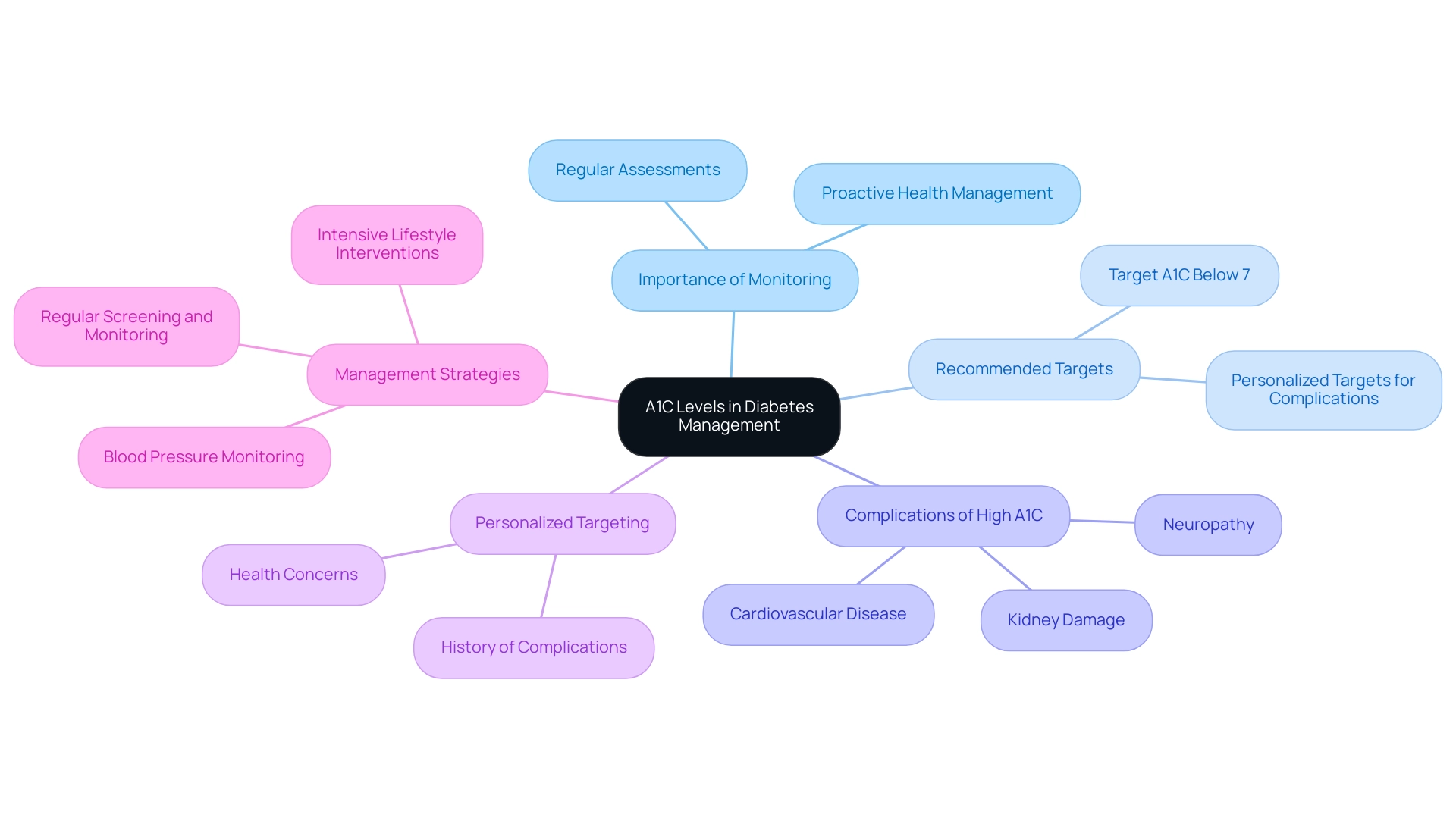
Interpreting Your A1C Results: What Do They Mean for You?
Interpreting A1C results is crucial for understanding blood sugar control and managing your health effectively. If your A1C level is below 5.7%, it is classified as normal. Levels between 5.7% and 6.4% indicate prediabetes, while a diagnosis of diabetes is confirmed when an A1C of 6.5% or higher is recorded on two separate tests.
For those of you who are already diagnosed, the general recommendation is to maintain an A1C below 7%. This target is significant because even a one percentage point reduction in A1C can lead to a substantial decrease in the risk of diabetes-related complications, such as cardiovascular disease and neuropathy.
In 2025, statistics reveal that a significant portion of patients with mild gestational glucose intolerance (GDM)—between 80% and 90%—can effectively manage their condition through lifestyle modifications alone. This highlights the importance of proactive management and lifestyle choices in maintaining your health.
Real-world examples illustrate the implications of A1C levels on blood sugar management. For instance, patients using second-generation antipsychotics may face a heightened risk of developing prediabetes. Regular screening for glucose disorders is essential, beginning at baseline, followed by rescreening after 12–16 weeks and annually. This proactive approach is vital for at-risk populations, underscoring the need for continuous monitoring and collaboration with healthcare providers.
As mentioned in a case study, monitoring is crucial for individuals on these medications to reduce risks related to blood sugar issues.
Expert opinions emphasize that understanding A1C results is best achieved within an interprofessional healthcare team environment. Eyth E. states, "Hemoglobin A1c is a valuable tool in managing blood sugar conditions and other glycemic control disorders, but it functions best in an interprofessional healthcare team environment to be effective." This collaborative approach ensures that you receive comprehensive care tailored to your individual needs.
As you navigate your healthcare journey, discussing any concerns with your medical professionals can lead to effective strategies that enhance your quality of life. Remember, you are not alone in this journey—if you feel overwhelmed, please reach out to your healthcare providers. Communication is key to effective care.
Additionally, it is important to recognize the broader implications of managing this condition. The incidence of type 1 diabetes has significantly increased among children and adolescents, particularly in non-Hispanic Asian or Pacific Islander groups from 2002 to 2018. This trend emphasizes the necessity for continuous education and support for all individuals impacted by this condition.
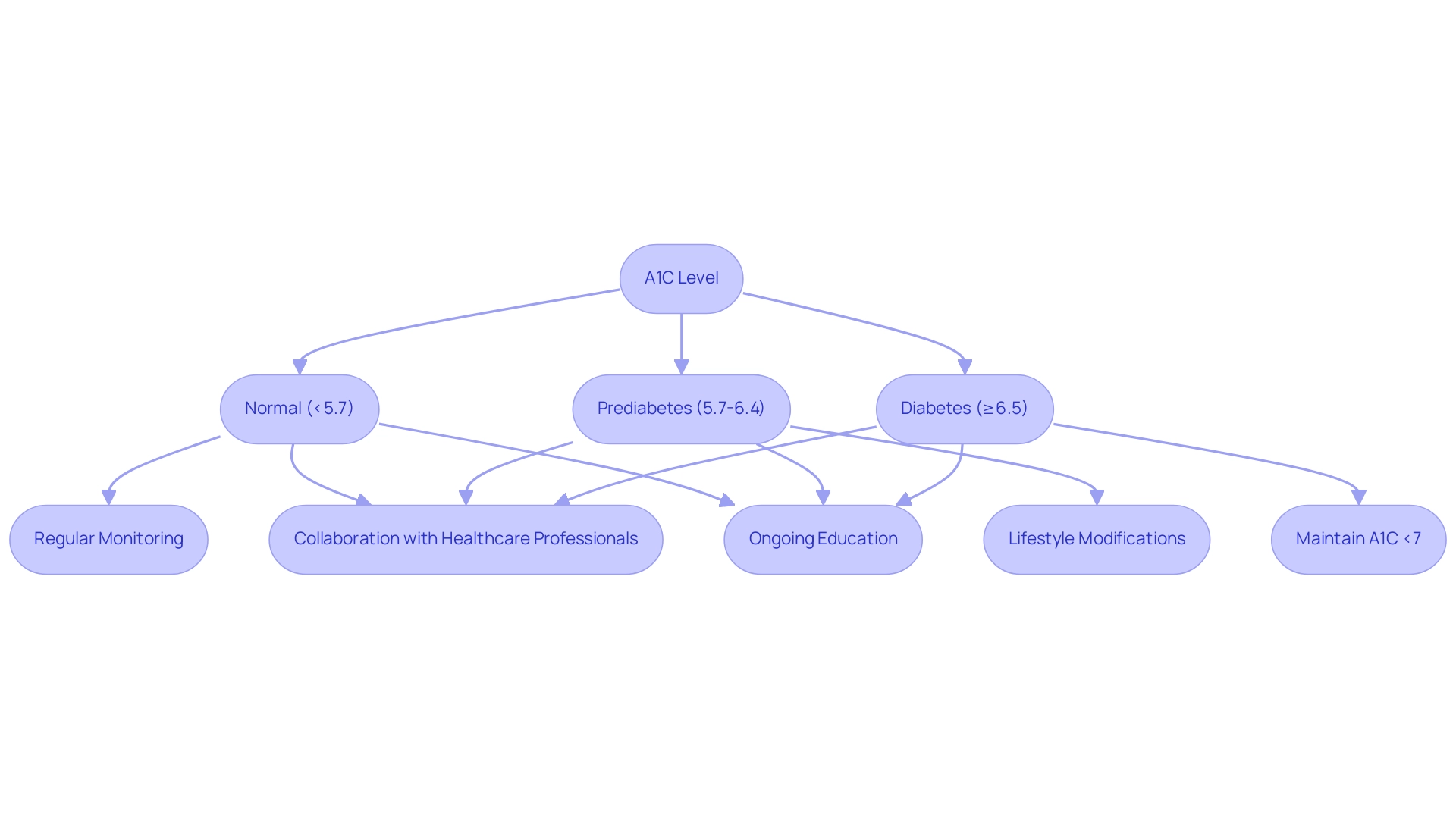
How Often Should You Test Your A1C? Guidelines and Recommendations
The frequency of A1C testing is tailored to your unique circumstances and treatment plans. According to the American Diabetes Association's 2025 guidelines, most adults with diabetes should undergo testing at least twice a year if their blood sugar levels remain stable and within target ranges. However, if your treatment has recently changed or you’re finding it challenging to meet your blood sugar goals, more frequent testing—every three months—is advisable.
This consistent oversight is essential. It allows for prompt modifications to treatment strategies, enhancing your health control and reducing the likelihood of complications.
Recent case studies underscore the importance of A1C testing in comprehensive care for metabolic disorders. For instance, a study titled "Screening for Psychosocial Concerns in Diabetes" highlighted the implementation of screening protocols for psychosocial issues. It revealed that regular A1C testing can help identify patients who may be experiencing distress, depression, or anxiety. By addressing these psychosocial factors, healthcare providers can enhance overall management of your condition and support you more effectively.
In 2025, healthcare professionals continue to advocate for these testing frequencies. They emphasize that consistent monitoring of A1C levels is essential for informed decision-making regarding treatment adjustments. The American Diabetes Association's recommendations reflect a commitment to personalized care, ensuring that you receive the support you need to maintain optimal health outcomes. Furthermore, it is strongly advised that comprehensive nutrition education be provided at diagnosis and at least annually as needed, to assess your eating patterns in relation to weight status, age-appropriate growth, and cardiovascular disease risk factors.
Real-life examples show that patients who follow these testing guidelines frequently experience improved control of their condition. This emphasizes the significance of regular A1C testing as a fundamental aspect of effective care. Moreover, individuals with blood sugar issues who have been utilizing continuous subcutaneous insulin infusion (CSII) should maintain access through third-party payors. This further underscores the necessity for comprehensive care strategies.
You're not alone in this journey. We are here to support you every step of the way.
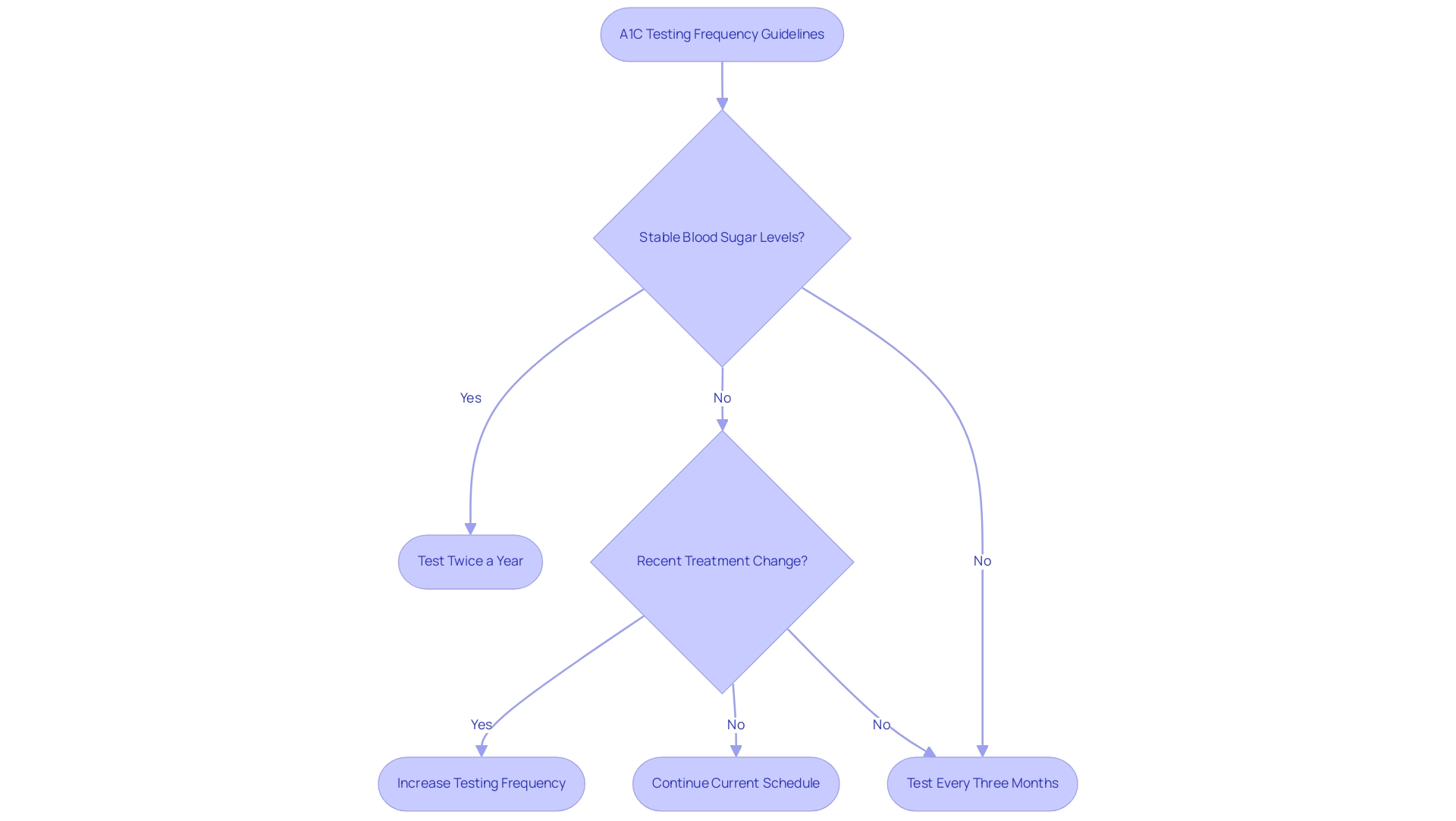
Tips for Improving Your A1C Levels: Practical Strategies for Better Management
Enhancing A1C values is essential for effective control of your condition, and it can be achieved through a combination of lifestyle changes and a steady commitment to treatment strategies. At T2DSolutions, we understand how overwhelming this journey can be for newly diagnosed patients. We strive to provide educational materials and community support to assist you in managing your condition. Here are some key strategies to consider:
-
Balanced Diet: Focus on a diet rich in whole grains, lean proteins, and a variety of fruits and vegetables. These dietary changes can significantly improve A1C readings, helping you feel more in control of your health.
-
Regular Physical Activity: Aim for at least 150 minutes of moderate exercise each week. Structured exercise programs lasting at least eight weeks have shown an average decrease in A1C levels by 0.66% among individuals with Type 2 diabetes. Both home-based and gym-based programs can enhance insulin sensitivity, particularly for youth with Type 2 conditions. As Absalon Gutierrez, an associate professor and endocrinologist, shares, "It is important for individuals at risk with blood sugar issues to take prevention seriously."
-
Track Your Progress: Using a blood sugar conversion table, regularly monitor your blood sugar readings. This practice will help you understand how different foods and activities affect your glucose levels, empowering you to make informed dietary and lifestyle choices.
-
Medication Adherence: It's crucial to take your medications as prescribed and maintain open communication with your healthcare providers about any concerns or side effects. This ensures that your treatment plans remain effective and tailored to your individual needs.
-
Stress Management: Incorporate relaxation techniques into your routine and consider joining support groups to manage stress effectively. Stress can negatively influence blood sugar levels, so focusing on your mental health is vital in managing your condition. Support groups can provide valuable resources and community assistance as you navigate your health journey.
By applying these strategies, you can see notable improvements in your A1C measurements and overall management of your condition. Recent studies highlight the connection between enhanced A1C readings and reduced chances of cognitive decline, especially in older individuals with Type 2 diabetes. Moreover, the increasing prevalence of Type 1 and Type 2 diabetes among young people underscores the urgent need for effective management strategies.
Remember, by adopting these lifestyle changes and staying committed to your treatment, you can enhance your health outcomes and quality of life. You're not alone in this journey; we are here to support you every step of the way.
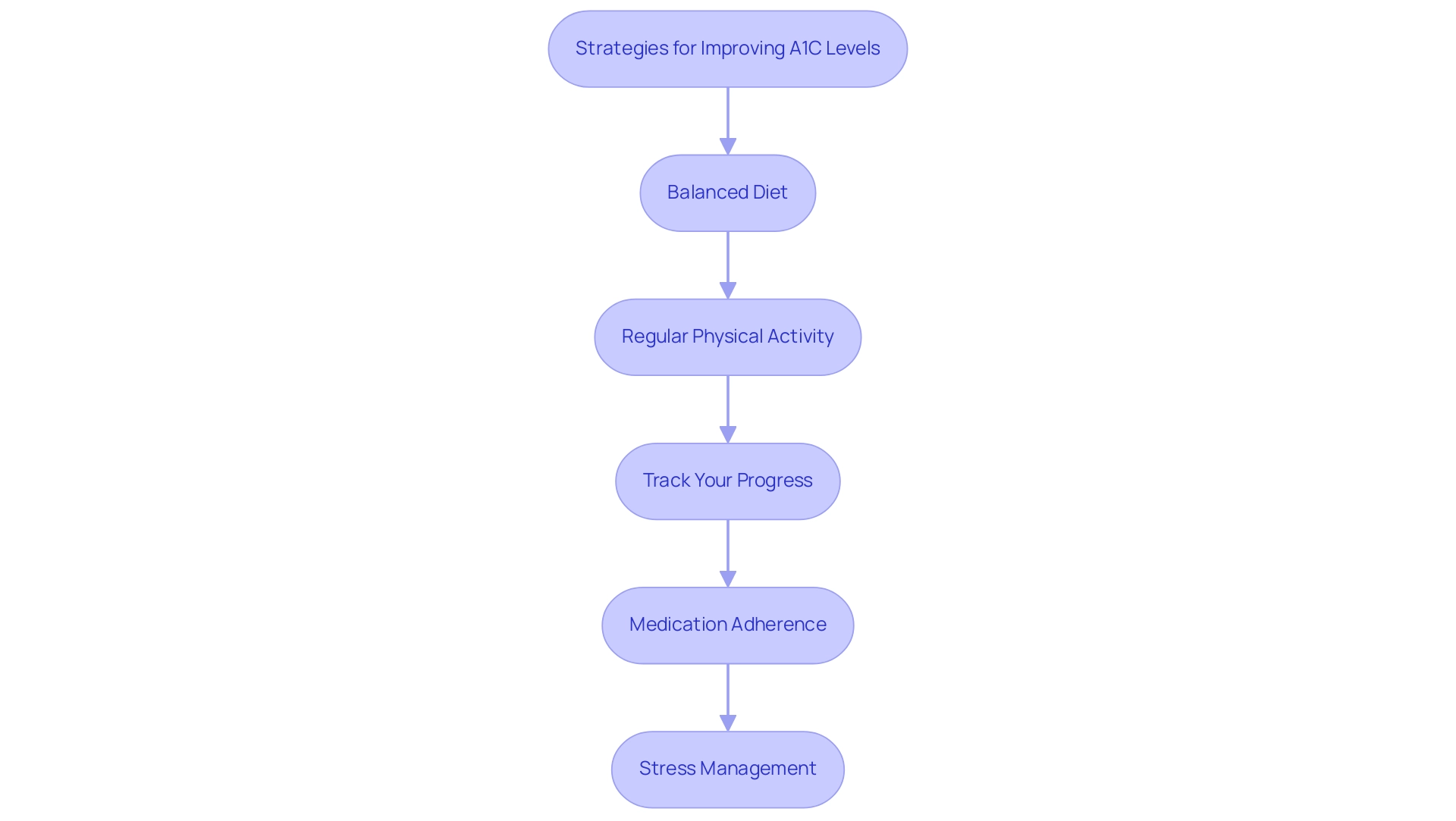
Understanding the Relationship Between Blood Sugar Levels and A1C
Understanding the relationship between blood sugar measurements and A1C is crucial for effective diabetes management. A1C serves as a key indicator of your average blood glucose levels over time. Typically, elevated blood sugar readings correlate with higher A1C percentages. For instance, a blood sugar level of 154 mg/dL usually results in an A1C of 7%. However, it's important to acknowledge that individual responses may vary significantly.
Factors such as stress, illness, and dietary choices can lead to fluctuations in your blood sugar readings, which in turn affect your A1C results. It's understandable to feel concerned about these changes, but current research highlights the importance of monitoring these fluctuations. They can profoundly impact your long-term health outcomes. Studies show that individuals who maintain stable blood sugar levels are more likely to achieve optimal A1C results, reducing the risk of diabetes-related complications.
In fact, statistics reveal that the average medical expenses related to diabetes have risen from $10,179 in 2012 to $12,022 in 2022. This underscores the necessity for effective control strategies. Real-life examples illustrate how diligent blood sugar management can lead to improved A1C results. Many individuals who actively monitor their glucose levels and make informed lifestyle choices report significant improvements in their A1C percentages. This proactive approach not only enhances overall health but also fosters a sense of community and support among those facing similar challenges.
As Charles 'Chuck' Henderson, CEO of the American Diabetes Association, emphasizes, "Enhancing the lives of individuals impacted by this condition is a key part of the ADA’s mission." The ADA provides the trusted support needed for individuals living with diabetes and those caring for them, helping them manage the disease and thrive until a cure is found.
Expert insights further reinforce the relationship between blood sugar levels and A1C. Advanced insulin delivery technologies can enhance glycemic outcomes, particularly for older individuals with a long-standing condition. By understanding the dynamics of blood sugar and A1C, you can refer to a blood sugar conversion table to make informed choices that positively impact your health journey. Additionally, T2DSolutions is committed to creating a supportive community for those affected by diabetes, encouraging individuals to share their experiences and connect with others facing similar challenges.
This focus on community fosters resilience and hope, leading to improved health outcomes through shared knowledge and support. T2DSolutions aims to provide comprehensive resources and education to empower you in your diabetes management efforts. Remember, you're not alone in this journey; we are here to support you every step of the way.
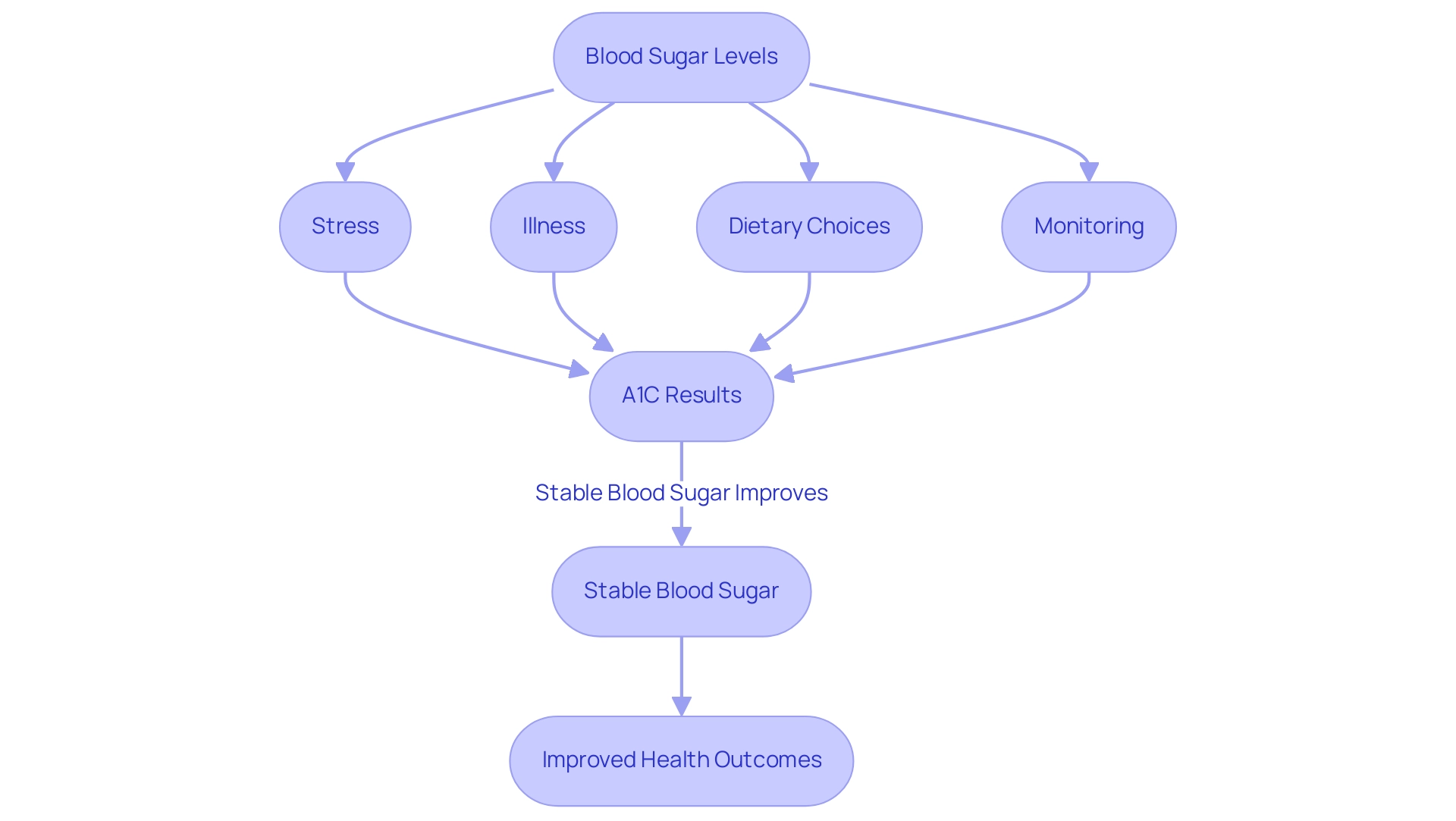
Conclusion
Understanding the complexities of A1C levels and blood sugar management is essential for anyone navigating the challenges of diabetes. It's understandable to feel overwhelmed by this journey. Throughout this article, we’ve highlighted the critical relationship between A1C measurements and long-term glucose control, emphasizing the necessity of regular monitoring to mitigate the risk of serious complications. With nearly half of adults with diabetes failing to meet recommended A1C targets, the urgency for effective management strategies cannot be overstated.
Practical strategies such as maintaining a balanced diet, engaging in regular physical activity, and adhering to medication plans are effective ways to improve A1C levels. Remember, you’re not alone in this; the importance of personalized care and the role of healthcare providers in guiding you through your management journey cannot be overlooked. Collaboration is key to achieving optimal health outcomes.
Ultimately, empowering individuals with knowledge and resources is vital for successful diabetes management. By actively monitoring blood sugar levels and understanding their implications, you can take meaningful steps toward better health. As the landscape of diabetes care continues to evolve, the commitment to education and support remains paramount. We are here to support you every step of the way, ensuring that you have the tools you need to thrive.



